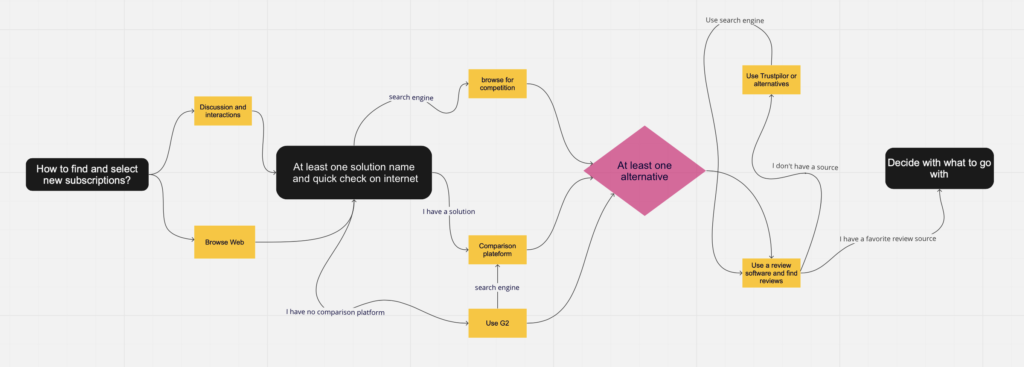So how do you find new services you want to use that can be offered on a subscription base?
The most obvious ways will be to get recommendations via colleagues or friends or from a presentation or a use case. These are great ways as a first filter makes it likely to increase the value for you.
However, we still usually look for alternatives, and often today, we tend to replace the discussion with a web engine search (by the way, check Ecosia for those interested in climate change).
So you can still use the good old discussion channel, which is excellent. I will then show you how to refine your search or do it from scratch, depending on your starting point.
Now from this point, we take for granted that you found a solution, and you quickly check it should fit your needs by browsing the website and seeing demos.
Let’s make a small stop and take a real example from a past experience. I want to find a collaborative whiteboard chart to brainstorm with colleagues remotely. A friend of mine introduced me to Miro. So I checked the website (https://miro.com), and I saw it has the features I was looking for.
The next step would be to select and compare solutions. Then, you can either do an Internet search for the competition or either use a platform to make it.
Back to my example, I checked on Google “Miro alternatives” and “Miro competition.” I found Lucidchart and an article with 10 Miro alternatives in 2022. That is the world we live in today.
I’m a bit of a nerd, and I prefer to go with a good option from the start, so I double-check using a comparison platform. I recently found G2, which I like, but you have over like Capterra, Sourceforge, etc. In all cases, you should use the one you like the most. What I like with G2 is the graphical presentation where you get an idea of competition, functionalities, and pricing quickly. We can also see some reviews and that it is mainly business software oriented, so it is not a complete database with all solutions.
Imagine I look for a website to check the wind for my outdoor adventure; you won’t find it here (you can type ”Windfinder” to test it).
So now that I have more information, I discovered alternatives I can quickly compare and check their solution.
Am I done?
I would recommend you to go for an additional step here. I appreciate having multiple independent reviews from users to corroborate the business reviews or the testimonials. The more, the better, and if you have time, I even encourage you to read a few, so you are more likely to find someone with the same feeling as you and read their detailed review.
In this step, you look for a site providing reviews. I usually go with Trustpilot, and here again, you should select the one you trust. An alternative could be Sitejabber. And the funny thing is now you have names; you just put them in the step above, and you collect competition before choosing the tool you like (who said we are not professional in Loops?).
As Trustpilot covers smaller businesses, I am able to find “Windfinder” reviews in this case, but only with 12 reviews (at this point in time). I will be nice, and so I will not enter into statistical considerations, but this is a bit low to get a reliable figure. I decided then to do a quick search, and I got a rating from the Google Play store with more than 50 000 reviews (yes, that’s enough in this case!).
Conclusion
I guess you get the point.
For those who like formal processes, here you get my process recommendation in the flowchart attached. (Click to enlarge)
Then you only have to enjoy your new toy.
What can LoopEye do for you here?
Here the simple idea we have is to use the community, which means to give you an additional source for getting exciting tools.
How do we plan to do this? By suggesting to you unbiasedly some of the subscriptions that people with almost the same subscription portfolio have. It should beat in quality most of the recommendations and reviews.
As usual, we love your feedback, so don’t hesitate to contact us with ideas or questions.
Ps: A bonus for the readers that survive this post.
For the reviews to be statically relevant, you should aim to have more than 50 reviews of the solution you want to assess.
So look for more than 50 reviews and be skeptical if there are less than 50.
Guess with what software I made the flowchart?







